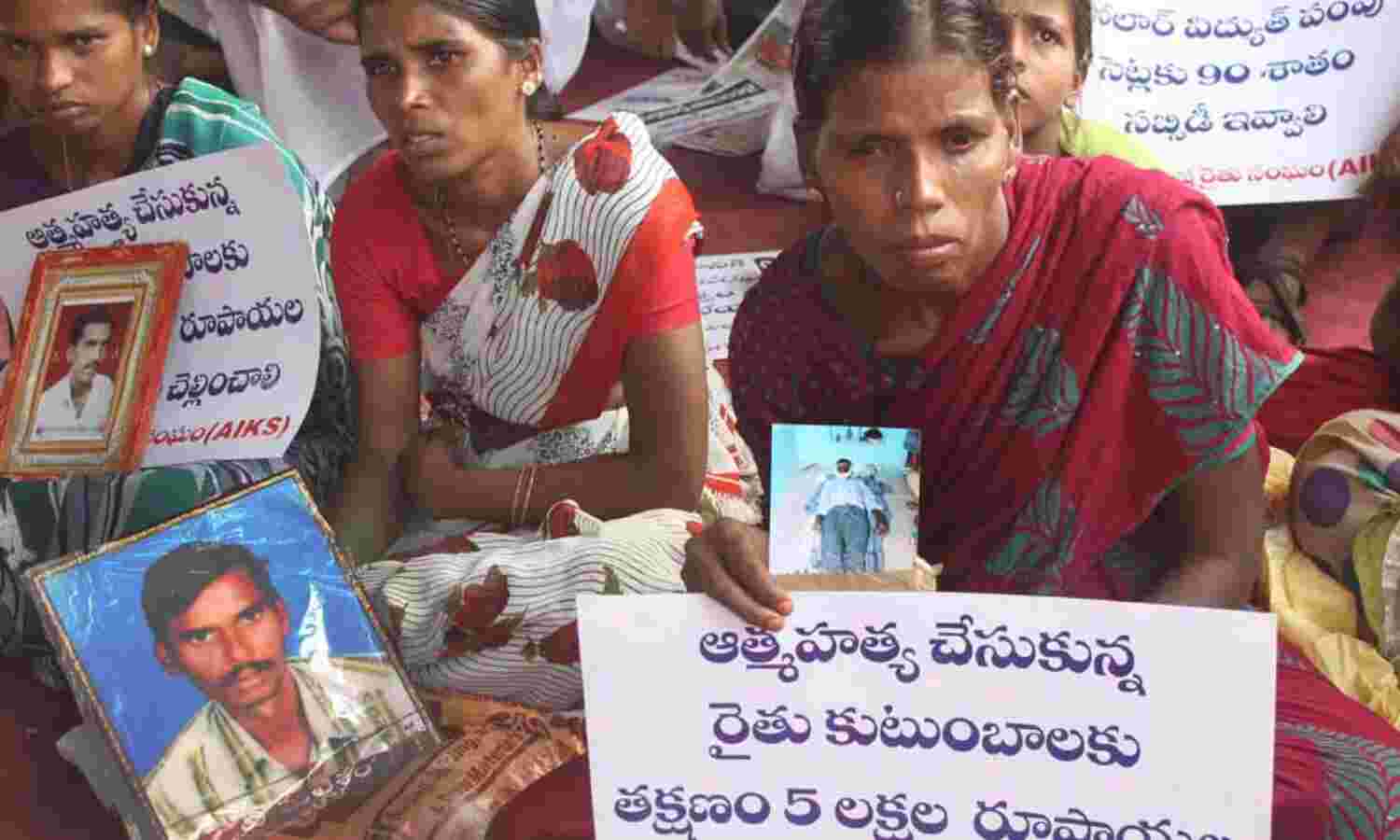Farmer Suicides Down 21% In 2016; Farming Sector Suicides At Decade Low

Hyderabad: Family members of the farmers who committed suicide stage a demonstration in Hyderabad on Nov 17, 2014.
Mumbai: As many as 6,351 farmers/cultivators committed suicide in 2016 across India, or 17 every day, according to the latest home ministry data. Suicides declined 21% from 8,007, or 22 every day, in 2015, data show.
Suicides in the farming sector declined 10%--from 12,602 in 2015 to 11,370 in 2016--according to this reply to the Lok Sabha (lower house of Parliament) by Parshottam Rupala, minister of state for agriculture and farmer welfare, on March 20, 2018.
The minister’s reply, based on provisional data from the National Crime Records Bureau (NCRB), a division of the home ministry, did not reveal the causes for suicides in 2016.
"As per NCRB report of 2015, bankruptcy or indebtedness and farming-related Issues are reported as major causes of suicides among farmers/ cultivators,” the minister said in his reply. “Family problems followed by Illness are reported as major causes of suicides among agricultural labourers."
Suicides of agricultural labourers increased 9% to 5,019 in 2016 (14 every day) from 4,595 in 2015 (13 every day).
Source: Lok Sabha; *2016 data is provisional
Suicides in the agriculture sector declined 32% in 2016 from 2007, the lowest over the last decade. The most--17,368--suicides over the last 10 years were reported in 2009 .
India’s agriculture growth rate has been volatile: From 1.5% in 2012-13 to 5.6% in 2013-14, -0.2% in 2014-15 to 4.9% in 2016-17 and 2.1% in 2017-18 (based on the first advance estimate).
India’s agriculture sector is excessively dependent--52% of India’s farmland is not irrigated--on the annual monsoons, which climate change is making ever more erratic, IndiaSpend reported on June 8, 2017.
“The preponderance of small and marginal holdings makes this high volatility even more worrisome as small and marginal farmers are highly vulnerable to adverse climatic conditions,” said the State of Indian Agriculture 2015-16 report.
Maharashtra reported most farmer suicides in 2016
Maharashtra reported the most (40%) farmer/cultivators suicides (2,550 or seven every day) in 2016, followed by Karnataka (1,212), Telangana (632), Madhya Pradesh (599) and Chhattisgarh (585).
Farmer suicides in Maharashtra declined 16% in 2016 from the previous year.
Maharashtra also reported the most (22%) suicides by agricultural labourers (1,111 or three every day) in 2016, a 12% decline over the previous year.
Maharashtra was followed by Karnataka (867), Madhya Pradesh (722), Andhra Pradesh (565), and Gujarat (378).
Over 35,000 farmers--landless and landed--from across Maharashtra marched 180-km to Mumbai demanding complete loan waivers and transfer of tribal land to farmers, IndiaSpend reported on March 12, 2018.
Maharashtra features among the top four states with forest areas over which traditional dwellers such as tribal cultivators can be given land rights, IndiaSpend reported on March 16, 2018.
However, the state rejects nearly two-thirds of claims of community or individual tribal ownership of forest land, shows an IndiaSpend analysis of tribal ministry data. Of the 364,358 claims received until October 10, 2017, the state had rejected 64% (231,856 claims).
Farmer suicides in Tamil Nadu increased 18 times from two in 2015 to 36 in 2016. In all, 381 suicides in agriculture sector were reported in Tamil Nadu in 2016.
As many as 144 cultivators and agricultural labourers ended their lives in Tamil Nadu between October and December 2016, and 106 farmers were reported to have committed suicide in one month, IndiaSpend reported on January 10, 2017.
The retreating northeast monsoon in 2016 was the worst ever over the last 140 years since 1876. On January 5, 2017, reservoirs in Tamil Nadu were at less than 20% of their capacity, cited as the worst ever for the state.
Farmers from Tamil Nadu were protesting in Delhi between April and July 2017, demanding loan waivers, revised drought packages, a Cauvery Management Committee, and fair prices for their products, the Hindustan Times reported on July 19, 2017. The farmers protested with skulls and pairs of femur bones supposedly of farmers who had committed suicide due to drought and debt.
Stressed and burdened by indebtedness, successive crop failures and low yields, 4,659 farmers ended their lives in 2015, IndiaSpend reported on January 2, 2017.
About 52% of India’s agricultural households are indebted; with an average outstanding loan of Rs 47,000, according to Agricultural Statistics 2016 based on the National Sample Survey Office–Assessment Survey of Agricultural Households (Jan-Dec 2013), IndiaSpend reported on August 1, 2017.
Agricultural households with marginal holdings are the most indebted (64%) compared to 0.6% households holding large farms.
Nearly 70% of India’s 90 million agricultural households spend more than they earn on average each month, pushing them towards debt, IndiaSpend reported on June 27, 2017.
Nine other states--Madhya Pradesh, Rajasthan, Uttar Pradesh, Punjab, Haryana, Karnataka, Tamil Nadu, Andhra Pradesh, and Telangana--witnessed farmer agitations and protests demanding farm loan waiver and fair pay over the last year.
More than 3,000 farmers from seven states protested in February 2018 demanding loan waivers and higher prices for their crops from the central government on February 23, 2018, Scroll.in reported on February 25, 2018.
In June 2017, farmers in Madhya Pradesh’s Mandsaur protested demanding better fair for produce and loan waivers in drought-affected regions of the state, The Hindustan Times reported on June 7, 2017. Farmers agitated due to lack of government’s response, according to sources, the report said.
(Mallapur is an analyst with IndiaSpend and FactChecker.)
We welcome feedback. Please write to respond@indiaspend.org. We reserve the right to edit responses for language and grammar.


